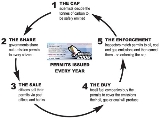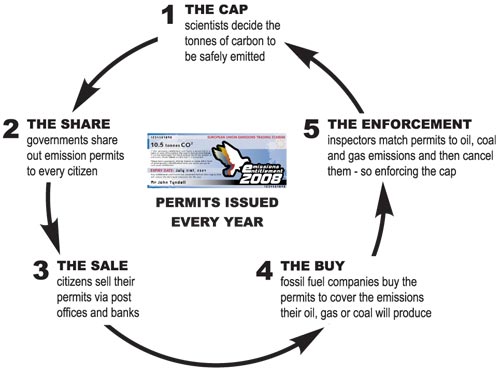
Cap and Share
Encyclopedia

Foundation for the Economics of Sustainability
Feasta, the Foundation for the Economics of Sustainability is an organisation based in Ireland which aims "to identify the characteristics of a truly sustainable society, articulate how the necessary transition can be effected and promote the implementation of the measures required for this purpose"...
(the Foundation for the Economics of Sustainability) and is a regulatory and economic framework for controlling the use of fossil fuels in relation to climate stabilisation. Accepting that climate change is a global problem and that there is a need to cap and reduce greenhouse gas
Greenhouse gas
A greenhouse gas is a gas in an atmosphere that absorbs and emits radiation within the thermal infrared range. This process is the fundamental cause of the greenhouse effect. The primary greenhouse gases in the Earth's atmosphere are water vapor, carbon dioxide, methane, nitrous oxide, and ozone...
emissions globally, the philosophy of Cap and Share maintains that the earth’s atmosphere is a fundamental common resource. Consequently, it is argued, each individual should get an equal share of the benefits from the limited amount of fossil fuels that will have to be burned and their emissions released into the atmosphere in the period until the atmospheric concentration of greenhouse gases has been stabilised at a safe level.
Design
This market based mechanism was devised by FeastaFoundation for the Economics of Sustainability
Feasta, the Foundation for the Economics of Sustainability is an organisation based in Ireland which aims "to identify the characteristics of a truly sustainable society, articulate how the necessary transition can be effected and promote the implementation of the measures required for this purpose"...
in 2005 and 2006, and they have set out the case for the introduction of Cap and Share globally in policy documents. It calls for global emissions to be capped at their current level and then brought down year by year at a rate fast enough to prevent catastrophic climate change. Each year, the emissions tonnage involved would be shared equally amongst the Earth's adult population, each of whom would receive a certificate representing their individual entitlement. The recipients would then sell their certificates through the banking system to oil, coal and gas producers who would need to acquire enough of them to cover the carbon dioxide emissions that would be emitted from all of the fossil fuel they sold. Everyone would receive at least partial compensation for the higher cost of fossil fuels that limiting their availability would necessarily involve.
Comhar, the National Sustainable Development Council of Ireland, commissioned a report on the mechanism which incorporates policy and economic analysis of using Cap and Share to control emissions in Ireland, particularly from the transport sector. The final report was published in December 2008.
Cap and Share is partly an extension and popularisation of the Contraction and Convergence
Contraction and Convergence
Contraction and Convergence is a proposed global framework for reducing greenhouse gas emissions to combat climate change. Conceived by the Global Commons Institute [GCI] in the early 1990s, the Contraction and Convergence strategy consists of reducing overall emissions of greenhouse gases to a...
proposal developed by the Global Commons Institute, which also calls for an equal per capita distribution of emissions. Cap and Share differs in that it insists that emissions allocations should be distributed equally to individuals as their right, whereas Contraction and Convergence (C&C) allows governments to decide if this is the way they wish to share out what is, essentially, their national allocation. C&C also allows for (but does not insist on) a convergence period, during which the richer countries would receive higher per capita emissions allowances than poorer countries. Cap and Share says people in rich countries should get the same emissions entitlement as those in poor countries from the start, but suggests that in the early years of the system, a portion of everyone's emissions entitlement should be held back and distributed to governments of countries which were facing exceptional difficulties in adapting to climate change or to low levels of fossil energy use. The governments involved would sell their certificates to raise money for remedial works. For example, the government of Bangladesh might sell its allocation to pay for better defences against rising sea levels.
Principles
- That a ceiling or cap on carbon dioxide and other green house gas (ghg) emissions from fossil fuels should be calculated that prevents an average global temperature rise of over 2 degrees Celsius.
- That the right to emit such ghgs is a human right, and should be shared on an equal-per-capita basis, with permits going to each individual rather than to their governments.
- That the permits would be saleable through the post office and banking system to the importers and producers of fossil fuels who would need to acquire enough permits to cover the emissions from the fuels they introduce.
- That any national or European Union scheme should be designed as a possible prototype for a global system that will also help set the conditions for the alleviation of poverty and the maintenance of biodiversity.
Economic assessment
If the future were known with certainty, then the economic implications of Cap and Share would equal the economic implications of a carbon tax with lump sum recycling—that is, the carbon tax revenue would be used to send every household a cheque in the post. Some argue that lump sum recycling is an inferior way to recycle the revenue of environmental taxes, and that this has been repeatedly confirmed for Ireland. The rationale is that with the carbon tax revenue coming into government coffers, it could be directly spent by the government rather than distributed to the population via cheques, and that other kinds of taxation, such as labour taxation, could be decreased correspondingly. It is argued that this would have a positive effect on GDP since there would be a greater incentive for firms to increase employment, and that it would also positively affect social equity, since labour taxes are regressive by nature.The NGO that developed Cap and Share, Feasta, argues that while it is definitely a good idea to shift the tax burden away from labour and towards capital, a carbon tax is not the optimal instrument for this purpose. Carbon taxes do not establish a predictable level of emissions cuts, unlike a cap, and can be vulnerable to short-term political pressures such as an increase in the price of oil, since a country's tax policy is usually adjusted each year in the annual Budget. Feasta suggests that if a carbon tax were to be introduced, it would work best in tandem with Cap and Share. The two policies could be used to help countries fine-tune their responses to climate change and Peak Oil
Peak oil
Peak oil is the point in time when the maximum rate of global petroleum extraction is reached, after which the rate of production enters terminal decline. This concept is based on the observed production rates of individual oil wells, projected reserves and the combined production rate of a field...
.
Feasta also advocates the introduction of a land-value-based tax
Land value tax
A land value tax is a levy on the unimproved value of land. It is an ad valorem tax on land that disregards the value of buildings, personal property and other improvements...
, which they believe could be used as a substitute for taxation on labour and could therefore have a similar effect on the market to a carbon tax.
As the future is not known with certainty, some argue that cap and share has all the drawbacks of quantity-based regulation for a stock pollutant. In the case of greenhouse gas emissions, the argument goes, price-based regulation (incl. a carbon tax with lump-sum recycling) is more robust to uncertainty and leads to lower welfare losses. Again, however, Cap and Share advocates argue that the problem of assuring that specific emissions targets are reached is not properly addressed by using a purely price-based mechanism for emissions reduction. From their perspective, a definite, substantial decrease in greenhouse gas emissions, carried out in an equitable way so that the poor are not adversely affected, is well worth a possible decrease in "welfare" as measured by GDP (a highly problematic instrument for measuring wellbeing).
See also
- Economics of global warmingEconomics of global warming-Definitions:In this article, the phrase “climate change” is used to describe a change in the climate, measured in terms of its statistical properties, e.g., the global mean surface temperature. In this context, “climate” is taken to mean the average weather. Climate can change over period of time...
- Carbon taxCarbon taxA carbon tax is an environmental tax levied on the carbon content of fuels. It is a form of carbon pricing. Carbon is present in every hydrocarbon fuel and is released as carbon dioxide when they are burnt. In contrast, non-combustion energy sources—wind, sunlight, hydropower, and nuclear—do not...
- Cap and dividendCap and dividendCap and Dividend is a market-based trading system which retains the original capping method of cap and trade, but also includes compensation for energy consumers...
- Emissions tradingEmissions tradingEmissions trading is a market-based approach used to control pollution by providing economic incentives for achieving reductions in the emissions of pollutants....
- Greenhouse Development RightsGreenhouse Development RightsGreenhouse Development Rights is a justice-based effort-sharing framework designed to show how the costs of rapid climate stabilization can be shared fairly, among all countries...
- Emissions Reduction Currency SystemEmissions Reduction Currency SystemEmissions Reduction Currency Systems are schemes that provide a positive economic and or social reward for reductions in greenhouse gas emissions, either through distribution or redistribution of national currency or through the publishing of coupons, reward points, social currency, or...
External links
- The Climate Cooperation wiki
- Cap and Share website
- Feasta (The Foundation for the Economics of Sustainability)
- nef (the new economics foundation)
- The Global Commons Institute
- Personal carbon tradingPersonal carbon tradingPersonal carbon trading is a general term referring to a number of proposed emissions trading schemes under which emissions credits are allocated to adult individuals on a equal per capita basis, within national carbon budgets. Individuals then surrender these credits when buying fuel or electricity...
- an alternative approach to allocating emissions rights directly to individuals

